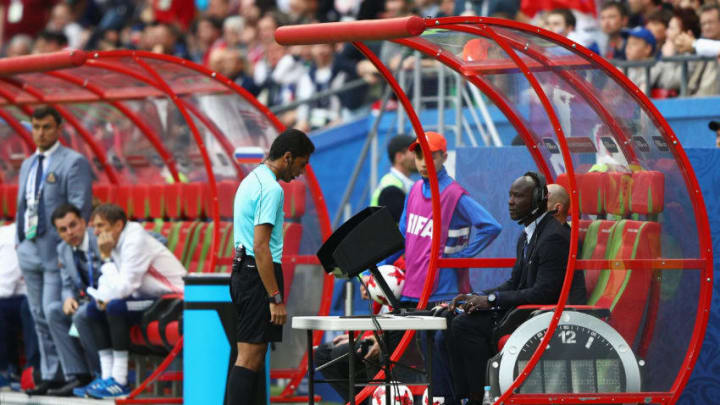FIFA unveiled Video Assistance Referees technology in this summers Confederation Cup, which got off to at best a mixed start but given time, it will greatly improve.
The biggest addition to this summer’s Confederations Cup was the announcement of FIFA using the competition as a test for the debut of VAR – Video Assistance Referee. The introduction of VAR into football has been long discussed for years, with referees clearly needing more help when making decisions with the standard of refereeing being very poor in particular this season.
There has long been a debate on whether video assistance should be brought into the game and if it was; how should it be implemented and whether or not it would slow down the flow of the game. Whether you fall into the argument for VAR or against VAR entirely falls down on whether you want a better standard of refereeing and the correct decisions being made or to keep the game not being stopped for minutes on end.
Using the Confederations Cup to test out VAR was a good decision. The Confederations Cup is nothing more than a tournament that is designed to allow the host nation for the World Cup to trial out their stadiums and get everything into order for the World Cup the next year. While it is a fun tournament to watch, there is not much on the line for the countries who are involved in it which is the perfect testing ground to trial out VAR.
More from Playing for 90
- Alexia Putellas reaches 400 games with Barcelona
- Everything you need to know ahead of the 250th ‘Super Clásico’
- Barcelona put five past Real Betis
- Manchester City suffer but come away with win over West Ham
- Baffling Liga MX ruling strips Puebla of a hard-earned victory
Using technology like this is never going to be perfect the first time that it is introduced, unlike goal-line technology which was rather simple and effortless to introduce, VAR is a much more complex to get right and ensure everything goes perfectly. Introducing it in the Confederations Cup allows them to test out both the pros and cons of the technology in a setting without much being on the line.
So, what has the results of VAR been? Well, it’s mixed.
The usage of VAR has caused quite the stir and controversy hasn’t been short in this tournament. Of course, none of this has happened because of the technology of itself. While it might have been controversial for some to see a goal for Chile in the group stage ruled out because Vargas was offside by a hair, in the end the decision was correct and it would have been very difficult for either the referee or the linesman to catch.
This is a welcome bonus along with the referee being able to go back and review a challenge in order to make what he believes is the best decision. This is a great concept because while it may be easy for the viewer on TV to see that the referee might have made the wrong decision on a foul or if a goal should have been disallowed, it is a whole different situation for the referees who prior to this tournament did not have the benefit of being able to watch a replay.
And this is where the problem of VAR comes from, at least in the Confederations Cup. The human element will always be there when factoring into decisions and that element will never be perfect which was evident in this tournament. Far too many times we had to witness a referee go back to review a foul or a fight and still end up making an incorrect decisions, which even went as far as seeing a referee sending off the wrong player despite watching footage of the foul!
The referees were nothing short of atrocious at the Confederations Cup and it is hard to blame the shortcomings of VAR on the actual technology itself when the referees fail to make proper decisions even after reviewing footage but it is a step in the right direction for football.
Related Story: West Brom linked with Holger Badstuber
There are ways that VAR can actually approve, it would be much better if they moved to a concept like Rugby where we can actually see what is going on and what they are looking at – especially in the instances of offside goals. Decisions do need to be made faster; the fact that it took one referee over two minutes to decide to give one player a yellow card is ridiculous.
But this will improve over time and this is why the Confederations Cup was the perfect testing ground for this system to work out the faults of the system but the technology itself was fine, the issues as usual come down to a very poor standard of referees and it will be very interesting to see what happens when a higher quality of referees are able to use VAR and make decisions.
